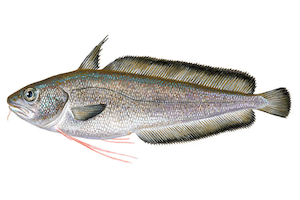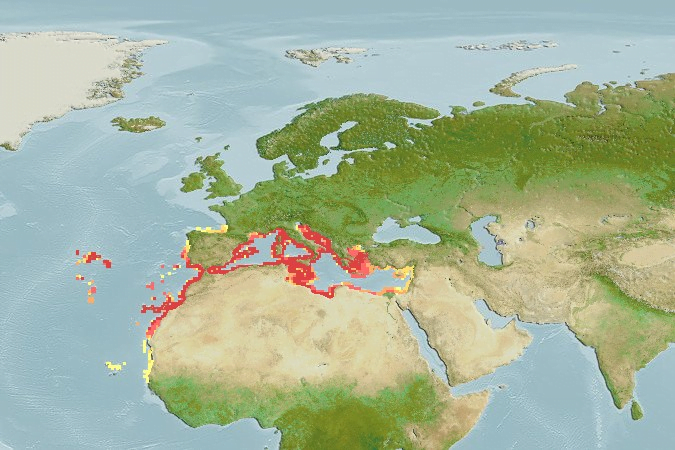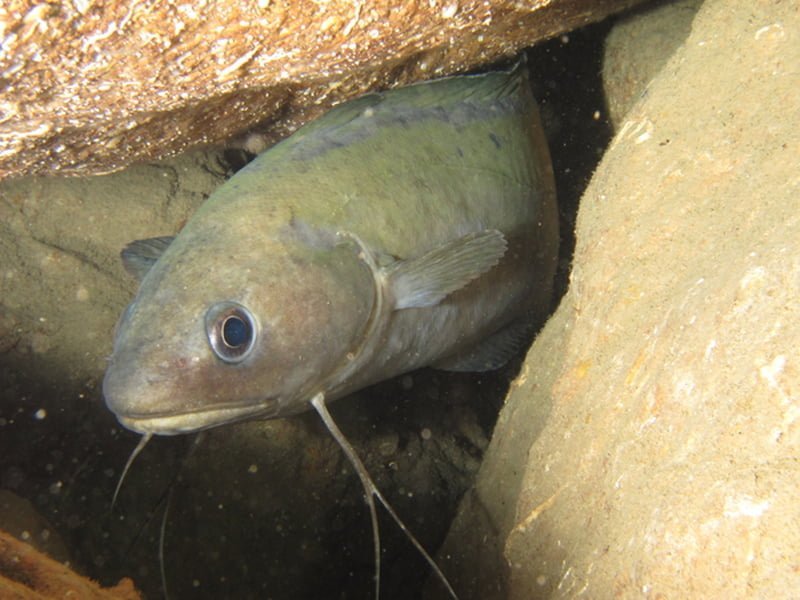Phycis Phycis
– Forkbeard –


| Conservation status |
|---|
 Least Concern (IUCN 3.1)[1] |
| Scientific classification |
Phycis phycis (Linnaeus, 1766)
| Kingdom: | Animalia |
| Phylum: | Chordata |
| Class: | Actinopterygii |
| Order: | Gadiformes |
| Family: | Phycidae |
| Genus: | Phycis |
| Species: | P. phycis |


Phycis phycis, the forkbeard, is a species of phycid hakes in the family Phycidae.[2][3]
Description
Phycis phycis commonly can reach a length of 25 centimetres (9.8 in), with a maximum length of 65 centimetres (26 in) in males.[2][4]
These fishes have a wide mouth with thick lips. A barbel is present on the chin. They do not have any thorn in the fins, but show elongated pelvic-fin rays reduced to bifid filaments, with 2 soft rays. The dorsal fin is a double and rounded (the first can have 9 or 11 soft rays, the second 56 or 65). The caudal fin is rounded, with 27 or 29 soft rays. Vertical fins distally reaching the origin of the anal fin. They are dark, sometimes with a pale margin. Body color is dark brown or gray on the back, but ventrally the color becomes paler.[2][5]
The Phycis phycis is a rock fish with an oblong body, with a maximum size of 60 cm. Brown in
color , light brown on the body to dark brown on the fins, this species can easily be distinguished by its barbel under the chin and its pelvic fins * in bifid filaments *.
The first dorsal fin is small and rounded, the second runs the rest of the body to the tail, which is also rounded at the tip. The anal, dorsal and caudal fins are surmounted by a white border.
The dark eyes, brown and black, are positioned in front of the head.
Distribution and Habitat
This species is present in the western Mediterranean, in Portugal and in western coast of northern Africa and the Azores. These fishes live on hard and sandy-muddy bottoms close to the rocks usually, at depths of 100–650 m.[2][5]
Biotope
Rocky bottoms, caves, holes and faults during the day. Most often in the coralligenous *. Mostelle is also common on areas of artificial reefs or any site where it may find dark areas. On the other hand, she is very mobile at night when she searches for food.
Etymology
Genus and species names Phycis derive from Greek, phykon meaning seaweed, as these fishes usually live hidden among seaweeds.[2]
Biology
Forkbeards are nocturnal, during the day they hide between rocks. They feed on small fish and several species of invertebrates. Breeding takes place from January to May.[2] They are relatively slow growing and long lived fishes.[6]
Alimentation
The mostelle is active at night: it is during this period that it will hunt crustaceans, worms or other small fish.
Reproduction
Spawning takes place from January to May. The larvae are planktonic.
Various Biology
Mostelle is quite common depending on the area. Approach slowly without too much lighting. It is a curious fish which observes you if you are far away, but which takes refuge in the hole when you approach, or comes to rest on the ground.
Similar Species
Gaidropsarus sp. (Motelle): 3 barbels, 1 chin bar and 2 on the muzzle, always on the bottom and more elongated body.
The Trident ( Raniceps raninus ), darker with the first dorsal extremely reduced, for the area of distribution they have in common.
It can be confused with capelin ( Trisopterus luscus ), but the latter has 3 dorsal and 2 anal fins.
Phycis blennoides (Brünnich, 1768), the bottom mostelle, has dark spots on the tip of the first dorsal and the center of the second. Rather on sandy / muddy bottoms around 100 m deep. Never encountered by divers.
Further Information
The mostelle is unfortunately easy to hunt but its tender flesh is damaged if the barb is badly planted, which allows it to escape the clumsy hunter without it surviving for a long time.
Like those of the corb, the otoliths * (in the form of small canines) of the adult mostelle are mounted as a jewel.
It is a fish appreciated for its flesh and which very easily attains a good size: it is thus very fished by small trades and by underwater hunters. It is rare to see small individuals.

















































































































































































































































































































































































